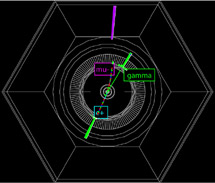
Handy Links
SLAC News Center
SLAC Today
- Subscribe
- Archives: Feb 2006-May 20, 2011
- Archives: May 23, 2011 and later
- Submit Feedback or Story Ideas
- About SLAC Today
SLAC News
Lab News
- Interactions
- Lightsources.org
- ILC NewsLine
- Int'l Science Grid This Week
- Fermilab Today
- Berkeley Lab News
- @brookhaven TODAY
- DOE Pulse
- CERN Courier
- DESY inForm
- US / LHC
SLAC Links
- Emergency
- Safety
- Policy Repository
- Site Entry Form

- Site Maps
- M & O Review
- Computing Status & Calendar
- SLAC Colloquium
- SLACspeak
- SLACspace
- SLAC Logo
- Café Menu
- Flea Market
- Web E-mail
- Marguerite Shuttle
- Discount Commuter Passes
-
Award Reporting Form
- SPIRES
- SciDoc
- Activity Groups
- Library
Stanford
Around the Bay
The Tau Lepton: Leading the Search for Lepton Flavor Violation at BaBar
 While much of the work at the SLAC B Factory has been on B-meson physics and the study of subtle matter-antimatter asymmetries in the laws of physics, a BaBar team has also been exploiting PEP-II's ability to produce copious quantities of another type of particle, the tau lepton.
While much of the work at the SLAC B Factory has been on B-meson physics and the study of subtle matter-antimatter asymmetries in the laws of physics, a BaBar team has also been exploiting PEP-II's ability to produce copious quantities of another type of particle, the tau lepton.
In the Standard Model of Particle Physics, the electron, the muon and the tau make up the family of fundamental particles called charged leptons, and each has a neutral partner called a neutrino. The tau, being relatively heavy, can decay into an electron or a muon, or into many other types of particle. In the Standard Model, modified to include the effects of recently discovered neutrino oscillations, tau-lepton decays almost always produce a tau neutrino, conserving a quantity called lepton flavor. The neutrinos are impossible to detect at BaBar, so their presence is inferred from missing energy, an imbalance between the energy of the original tau and the observed energy of its decay products.
In attempting to find deeper symmetries in nature, theorists have postulated many extensions to the Standard Model. The so-called supersymmetry theories are particularly appealing. Many variants of these theories predict a significant amount of lepton-flavor violation, allowing a tau to decay without producing a tau neutrino. One important process of this type would be the decay of a tau to a muon plus a photon. Such an event would have a distinctive signature in BaBar: the muon would be reconstructed in the particle tracking system and the muon detectors, while the photon would be seen in the electromagnetic calorimeter. Since no energy would be taken away by a neutrino, the total energy of the combination of the muon and the photon would be equal to the original tau energy. Also, the reconstructed mass of the muon plus photon system would be the same as the tau mass. The figure (above) shows a simulation of such an event in BaBar.
The BaBar team has so far looked at over 400 million tau lepton decays, searching for evidence for the decay of a tau to a muon plus a photon. No signal has been found. This has allowed the BaBar physicists to calculate that the probability for such a decay must be no larger than one in fourteen million. This small probability rules out several versions of supersymmetry theories, and has allowed physicists to place limits on the range of possible values of some important parameters in other versions of the theories.
Recently, during the PEP-II shutdown, the installation of new detectors at BaBar has enhanced the capability of the experiment to identify muons. When the accelerator starts up again for physics, the luminosity is expected to reach record levels, allowing BaBar to accumulate even more, higher quality data. The tau analysis team is ready to resume the search for lepton flavor violation with the new data. At the very least, further important constraints will be put on the nature of possible new physics beyond the Standard Model. But evidence for lepton flavor violation just might be found before the end of data taking in 2008.
—George Lafferty
SLAC Today, December 7, 2006
Above image: A simulated tau-tau+ event in the BaBar detector. The negative tau decays into a muon (mu-) and a photon (also known as a gamma ray). The green line shows the path of the photon, which leaves no track in the tracking chambers, but deposits its energy in the electromagnetic calorimeter (shown as the green tower). The muon produces hits in the tracking chambers, traverses the calorimeter and leaves its trace in the muon chambers (seen as the purple tower). The positive tau decays into a positron (e+) plus neutrinos, with the latter being undetected and carrying missing energy. (Image courtesy of Swagato Banerjee.)